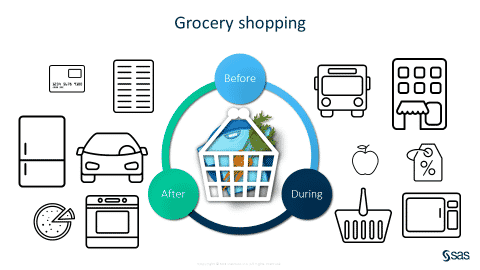
Nov 6, 2017
What does Yoghurt have to do with Analytics? Thanks for asking…
Several years ago I contributed a piece of advice in a colleague’s blog about hiring data scientists. I made the analogy that skills in analytics are attained over time, as with the layers formed from swirling frozen yoghurt (froyo). Like me, you may have started as a math geek a.k.a. quant skills, and then picked up tech skills to apply in projects of a variety of subject matter, while learning to better communicate insights. As time goes on, you get more comfortable in each area until you decide which skills (layers) you want to keep developing, just maintain, or let melt away.
1. Froyo is better when it’s creative
Imagery wasn’t used very much in my maths degree, but the facts I learned have been vital in my career. When I started tutoring classes, I realised that most students didn’t appreciate these facts, let alone commit them to memory. One day, I used an analogy of dogs jumping through hoops to explain a statistical concept. It was blurted out in desperation for a “lightbulb moment” – but it worked. And even better, it seemed to stick with my students. Imagery is a potent memory trick.
Nowadays, I give guest lectures at universities on why and how art and science work best when used together. One part covers the use of art in or for science. From the creativity required to decide on an analytical approach to the use of visuals and verse to explain complex analytical concepts and outputs – the combination is powerful.
You don’t need to be an artist to be creative. Just apply the grandma (not an expert) test: take the detailed expert knowledge in your head and figure out how to explain it to grandma. You’ll be surprised by what happens! Think not out-of-the-box but around the lip of a froyo cup.
Figure 2 Interactive exercise I created to illustrate the use of analytics in everyday decision making
2. Froyo is better when it’s different
Yoghurt or Yogurt? According to my spell check, both are valid options in English (Australia). Whichever way, I prefer the frozen variety.
All froyos share the same foundations: they need to be cold, they need to be made of yoghurt, there needs to be a tub to hold them, and there need to be a spoon to eat them with, etc. As in analytics: there needs to be an initial problem, there needs to be data, there needs to be algorithms and there needs to be tools, etc. And also like froyo, the differences in approaches analysts use provide added value.
One analyst’s decision tree modelling for segmentation is another’s predictive model. One analyst’s preference for extreme gradient boosting is another’s preference for deep learning. One analyst’s demand forecasts for planning is input into another’s route optimisation. Is either wrong? Most of the time the answer is “no”. Knowing the situations when the answer is “yes” is important, but being right in analytics is subjective – which is both liberating and terrifying. Effective analysts back themselves and, in the words of Vanilla Ice, take the opportunity to stop, collaborate and listen because it can lead to a brand new invention.
Figure 3 Macro photography of natural snowflake by Alexey Kljatov
3. Froyo is better with friends
Outside of work I am an avid amateur theatre actor. I started acting again as an adult because I remembered how much I loved it at school. I didn’t realise how much it would affect my analytics life.
I’ve been on many presentation skills courses on how to prepare, stand, speak and get over nerves, but nothing is quite the same as being on stage halfway through Act 1 in front of a paying audience when someone drops a line. You learn very quickly to keep breathing and practice rapid memory recall – invaluable skills for presentations.
I also learned how to care when I’m just not in the mood. When you don’t have an understudy, not turning up lets down the whole ensemble. If I’ve had a bad day, it’s not someone else’s problem – the people you’re with shouldn’t suffer. I regularly give motivational guest lectures at night after a long work day. Sore feet, late nights – it can be difficult to push through the pain and act authentic but being “easy to work with” and forming good relationships is priceless in a specialist field.
Figure 4 Meerkat gang playing at the San Diego Zoo by Matt Britt.
4. Froyo is better all year round
When you take up a career in Analytics, it stealthily slips beyond the 9 to 5 into your everyday life. I don’t mean that you’re forced to work longer hours than the norm, but the way you look at everyday things may start to evolve. When your brain is required to think so specifically – analysing and interpreting data at a detailed level – it becomes difficult to just let it go outside of work.
One thing that happens to me is that I consciously build self-learning models in my head: each time I meet someone, or experience a behaviour, I update my models. Everyone does this unconsciously which is why there’s a focus on replicating this with AI models. In my head though, I sometimes see the information being captured.
I also expect a higher level of service because I know how impactful analytics can be whatever your business is. I judge my nail salon for not having enough staff (bad forecasting), I get annoyed that an organisation thinks there are two of me (bad data quality), and I really wish a loyalty program would stop spamming my email with offers for wine (bad profiling).
Figure 5 Four Seasons in Japan by Masakazu Matsumoto
Let your layers build and get better with time. Analytics will take you to interesting places in your life but it’s your creation to swirl and decorate the way you want. Create your own unique froyo.
Check out vacancies in Data Analytics today.








